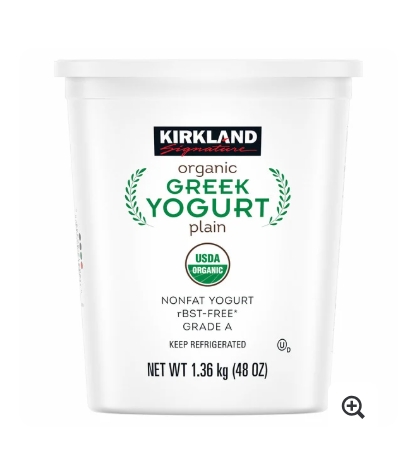
Kirkland Signature Organic Greek Yogurt, 48 oz
- USDA Organic; Kosher; Gluten Free; Grade A; Milk From Cows Not Treated with rbST.
Discovering Quality, Value, and Versatility in Every Spoonful
As I stood in the cavernous refrigerated section of my local Costco, basket already half-filled with bulk paper towels and that impulse-buy rotisserie chicken (we’ve all been there), my eyes landed on the distinctive two-pack of Kirkland Signature Greek Yogurt. Like many Costco devotees, I’d passed by this unassuming product countless times without giving it much thought. But on this particular shopping trip, curiosity got the better of me.
Three weeks and several empty containers later, I realized I’d been missing out on one of Costco’s most impressive store-brand offerings. That spontaneous purchase sparked my deep dive into everything there is to know about this dairy aisle standout—from nutrition facts to culinary applications and everything in between.
What makes Kirkland Greek Yogurt truly exceptional isn’t just its quality or price point, but the remarkable versatility it brings to your kitchen and lifestyle. Whether you’re a protein-focused fitness enthusiast, a budget-conscious parent, or simply someone who appreciates good food, this comprehensive guide will explore why this humble yogurt deserves a spot in your shopping cart during your next Costco run.
What Exactly Is Kirkland Greek Yogurt?
Before we dive deeper, let’s establish what we’re talking about. Kirkland Greek Yogurt is Costco’s private-label version of Greek yogurt, sold under their signature house brand. But this isn’t just any store-brand imitation—it’s a legitimate Greek yogurt made through the traditional straining process that removes excess whey, resulting in that characteristically thick, creamy texture we associate with authentic Greek yogurt.
The standard offering comes in a two-pack of 32-ounce containers, though packaging may vary by location and season. While the plain, unflavored variety is the flagship product, Costco has occasionally rotated in other variations, which we’ll discuss later.
What immediately sets Kirkland’s version apart from regular yogurt is its density and protein content. The straining process concentrates the yogurt, removing liquid while retaining the protein, creating that signature thick consistency that stays on your spoon without running off—a textural pleasure that makes it as satisfying to eat as it is nutritious.
The Hunt: Where to Find and How Much It Costs
The most obvious place to find Kirkland Greek Yogurt is, unsurprisingly, at your local Costco warehouse. It’s typically located in the refrigerated dairy section, often near other yogurt brands and dairy products. The product is a staple in most Costco locations across the United States, though availability can sometimes vary by region.
For those who prefer online shopping, Kirkland Greek Yogurt is occasionally available through Costco’s website or delivery partners like Instacart, though refrigerated shipping may add to the cost.
As for pricing, this is where Kirkland’s offering really shines. At the time of writing, a two-pack of 32-ounce containers typically retails between $5.99 and $7.99, depending on your location. Breaking that down, you’re looking at approximately $0.09 to $0.12 per ounce—significantly less than premium brands like Chobani or FAGE, which often cost $0.15 to $0.25 per ounce when not on sale.
This pricing makes Kirkland Greek Yogurt one of the most economical ways to incorporate high-quality protein into your diet, especially when purchased in Costco’s characteristic bulk packaging. The cost-effectiveness becomes even more apparent when you consider how versatile this product is, serving as everything from a breakfast staple to a cooking ingredient.
The Nutrition Breakdown: What’s Really in the Container?
Let’s talk about what you’re actually consuming when you dig into a container of Kirkland Greek Yogurt.
Milk Base: Whole vs. Nonfat
Kirkland offers both whole milk and nonfat varieties of their Greek yogurt, catering to different dietary preferences. The whole milk version delivers that luxurious, creamy mouthfeel that makes yogurt feel indulgent, while the nonfat option appeals to those monitoring fat intake or seeking a lighter option.
The whole milk version typically contains about 4% milkfat, giving it a richer texture and slightly higher calorie count. The nonfat version, as the name suggests, has had virtually all the fat removed, resulting in a tangier, slightly less creamy product that still maintains the characteristic thickness of Greek yogurt.
Is It Organic?
At present, Kirkland Greek Yogurt is not certified organic. The standard offering uses conventional milk rather than organic milk. However, Costco is known for being responsive to consumer demands, and given the growing interest in organic products, it wouldn’t be surprising to see an organic option in the future.
That said, Costco does maintain strict quality standards for all Kirkland Signature products, often working with the same suppliers that produce name-brand items.
Ingredients: Simplicity is Key
One of the most appealing aspects of Kirkland Greek Yogurt is its simple, clean ingredient list. The plain variety typically contains just two ingredients: cultured pasteurized milk and live active yogurt cultures.
These cultures usually include standard yogurt starters like Lactobacillus bulgaricus and Streptococcus thermophilus, as well as additional probiotic strains that contribute to the yogurt’s health benefits.
Unlike many commercial yogurts, Kirkland’s plain Greek yogurt contains no added sugars, artificial sweeteners, preservatives, stabilizers, or thickeners. This simplicity is part of what makes it both versatile for cooking and appealing to health-conscious consumers.
Sugar Content: The Natural Story
The plain variety of Kirkland Greek Yogurt contains no added sugar—only the naturally occurring lactose from milk. This typically amounts to around 4-6 grams of sugar per serving, depending on whether you choose whole milk or nonfat.
This low sugar content makes it an excellent option for those monitoring their sugar intake or following low-carb eating plans. It also provides a neutral base that can be customized to your taste preferences, whether you prefer to add a drizzle of honey for sweetness or keep it savory with herbs and spices.
Protein Powerhouse
Perhaps the most impressive nutritional aspect of Kirkland Greek Yogurt is its protein content. A single 6-ounce serving typically delivers 16-18 grams of complete protein, making it one of the most protein-dense foods in the dairy category.
This high protein content has made Greek yogurt in general—and Kirkland’s version specifically—a favorite among fitness enthusiasts and those looking to increase their protein intake without relying on supplements. The protein in Greek yogurt is particularly valuable because it contains all nine essential amino acids, making it a complete protein source.
The Comparison: How Does It Stack Up Against Premium Brands?
Many yogurt enthusiasts wonder how Costco’s private label option compares to established Greek yogurt brands like Chobani and FAGE. Having sampled all three extensively, I can offer some insights on the similarities and differences.
Texture and Taste
In terms of texture, Kirkland Greek Yogurt falls somewhere between Chobani and FAGE. It’s not quite as ultra-thick as FAGE, which can almost stand up to being cut with a knife, but it’s definitely denser and creamier than Chobani’s slightly looser consistency.
Taste-wise, Kirkland offers a balanced flavor profile—it has the characteristic tanginess of Greek yogurt but isn’t as aggressively tart as some premium brands. The whole milk version has a richer, more rounded flavor that softens the tanginess, while the nonfat version is brighter and more pronounced in its acidity.
Nutritional Comparison
Nutritionally, Kirkland’s offering is remarkably similar to premium brands. The protein content is virtually identical to both Chobani and FAGE, hovering around 16-18 grams per serving. Sugar and fat content are also comparable when comparing similar varieties (whole milk to whole milk, nonfat to nonfat).
The main differences emerge in the flavored varieties—Kirkland tends to offer fewer flavored options than the major brands, and when they do appear, they typically contain similar or slightly less added sugar than their name-brand counterparts.
Value Proposition
Where Kirkland Greek Yogurt truly differentiates itself is in value. Ounce for ounce, it typically costs 30-50% less than premium brands, making it significantly more economical for regular consumption.
This cost advantage becomes even more pronounced when using Greek yogurt as an ingredient in cooking or baking, where you might use substantial quantities. Many home cooks find they can use Kirkland for these culinary applications while perhaps reserving more expensive brands for occasions when they’re enjoying yogurt on its own.
Dietary Considerations: Will It Work For Your Lifestyle?
Gluten-Free Status
Good news for those with celiac disease or gluten sensitivity: Kirkland Greek Yogurt is naturally gluten-free. The plain variety contains no gluten-containing ingredients, making it a safe option for those avoiding gluten.
However, as with any food product, those with severe gluten allergies should be aware that while the ingredients themselves are gluten-free, Costco doesn’t specifically market the product as certified gluten-free, which would require additional testing for cross-contamination.
Probiotic Benefits
Like most yogurts, Kirkland Greek Yogurt contains live active cultures—beneficial bacteria that can support gut health. These typically include the standard yogurt cultures (Lactobacillus bulgaricus and Streptococcus thermophilus) as well as additional probiotic strains.
These probiotics can contribute to digestive health and immune function, making yogurt more than just a protein source. The cold processing of Greek yogurt helps preserve these beneficial bacteria until they reach your digestive system.
Weight Management Potential
With its high protein content and relatively low calorie count (especially the nonfat variety), Kirkland Greek Yogurt can be an excellent addition to a weight management plan. The protein helps promote satiety, potentially reducing overall calorie intake by keeping you fuller longer.
Additionally, the versatility of Greek yogurt means it can replace higher-calorie ingredients in many recipes. Using it in place of sour cream, mayonnaise, or oil in certain dishes can significantly reduce the calorie content while maintaining satisfying flavors and textures.
Keto Compatibility
For those following a ketogenic diet, the answer is nuanced. The plain whole milk version of Kirkland Greek Yogurt contains approximately 4-6 grams of naturally occurring sugar (lactose) per serving, which comes from the milk itself.
While this is relatively low compared to many foods, strict keto dieters who aim to keep their carbohydrate intake below 20 grams daily may need to portion carefully. However, many following a more moderate low-carb approach find that the high protein and fat content of the whole milk variety makes it a workable option when consumed in moderation.
The Practical Matters: Storage, Shelf Life, and Handling
Refrigeration Requirements
Like all fresh dairy products, Kirkland Greek Yogurt requires consistent refrigeration at or below 40°F (4°C). Allowing it to sit at room temperature for extended periods can compromise both safety and quality.
Shelf Life Expectations
Unopened, Kirkland Greek Yogurt typically has a refrigerated shelf life of 3-4 weeks from the packaging date. This is actually slightly longer than some premium brands, possibly due to the density of the product and its simple ingredient list without additives.
Once opened, however, the clock starts ticking more quickly. For best quality, consume within 7-10 days of opening. You’ll know it’s past its prime if you notice excess liquid, an off smell, or any mold growth.
The Whey Factor
One characteristic of Greek yogurt is the occasional separation of whey (the clear liquid that sometimes pools on top). This is perfectly natural and not a sign of spoilage—it’s simply the continued separation process that creates Greek yogurt in the first place.
You can either pour off this liquid or stir it back in, depending on your texture preference. I typically stir it back in for the additional protein and to maintain the yogurt’s consistency.
Consumer Experiences: What Are People Saying?
The Review Landscape
Kirkland Greek Yogurt enjoys a generally positive reception among Costco members. On various review platforms and forums dedicated to Costco products, it typically receives ratings between 4 and 4.5 out of 5 stars.
Most positive reviews highlight the value proposition and the clean, simple ingredients. The texture and taste are frequently praised as being comparable to more expensive brands. Negative comments, though relatively rare, sometimes mention inconsistency between batches or availability issues at certain locations.
Common Praise Points
When analyzing reviews, several themes emerge in the positive feedback:
- Value for money is mentioned in approximately 80% of positive reviews
- Protein content is highlighted by fitness-minded reviewers
- Versatility for cooking applications receives frequent mention
- The simple ingredient list appeals to health-conscious consumers
Criticism Patterns
The more critical reviews tend to focus on:
- Occasional texture inconsistencies between batches
- Limited flavor options compared to major brands
- The large container size being too much for smaller households
Beyond Plain: Flavor Varieties and Availability
Current Flavor Lineup
While the plain variety is Kirkland’s mainstay Greek yogurt offering, Costco has experimented with flavored options at various times. The availability of these can vary significantly by region and season.
Some locations have carried vanilla, strawberry, and blueberry varieties, while others have offered variety packs with assorted flavors. These flavored versions typically contain fruit preparations and added sugar, though generally at levels comparable to or lower than major brands.
Seasonal and Regional Variations
Costco is known for rotating products seasonally, and Kirkland Greek Yogurt is no exception. You might find special flavors during certain times of year—such as pumpkin in fall or tropical flavors in summer.
Regional preferences also influence availability, with certain markets receiving flavor varieties that perform well locally. This regional approach means that Costco members in different parts of the country may have access to different Kirkland Greek Yogurt options.
The Culinary Canvas: Cooking and Baking Applications
Beyond Breakfast: Cooking Applications
One of Greek yogurt’s greatest strengths is its culinary versatility, and Kirkland’s version excels in this area. Its thick consistency and tangy flavor make it an excellent substitute for higher-fat ingredients in many recipes.
Some popular cooking applications include:
- Replacing sour cream in dips, dressings, and toppings
- Substituting for mayonnaise in salads and sandwiches
- Creating creamy sauces without heavy cream
- Marinating meats (the lactic acid acts as a tenderizer)
- Preparing traditional Mediterranean dishes like tzatziki
Baking Chemistry: How It Performs in the Oven
In baking, Greek yogurt can be a powerful ingredient that adds moisture, tenderness, and a slight tanginess to baked goods. Kirkland Greek Yogurt works particularly well in:
- Muffins and quick breads, where it adds moisture without thinning the batter
- Cakes, where it can replace some or all of the butter or oil
- Pancakes and waffles, creating a fluffier texture
- Frosting and glazes, adding a pleasant tang that balances sweetness
The acid in yogurt also reacts with baking soda to help baked goods rise, similar to buttermilk in traditional recipes. When substituting Greek yogurt for other dairy in baking, you may need to adjust the liquid in your recipe slightly, as Greek yogurt is thicker than regular yogurt or milk.
The Manufacturing Story: Where Does It Come From?
Production Facilities
Kirkland Signature products are typically manufactured by leading producers in their respective industries, and the Greek yogurt is no exception. While Costco doesn’t publicly disclose the specific manufacturer of their Greek yogurt, industry analysis suggests it’s produced by one of the major dairy processors that also makes nationally recognized brands.
The yogurt is produced in facilities throughout the United States, with distribution generally organized regionally to ensure freshness. This regional production approach helps explain some of the subtle variations that consumers sometimes notice between different Costco locations.
Quality Control Practices
Costco is known for its stringent quality control standards, often exceeding industry requirements. For dairy products like Kirkland Greek Yogurt, this includes regular testing for bacterial content, consistency, flavor profiles, and nutritional accuracy.
The company’s approach to private label products involves identifying the highest quality manufacturers and negotiating favorable pricing based on volume, rather than cutting corners on ingredients or production methods. This philosophy helps explain how Kirkland can offer premium quality at substantially lower prices.
The Value Equation: Is It Worth Your Dairy Dollar?
Cost-Benefit Analysis
When evaluating Kirkland Greek Yogurt’s value proposition, several factors come into play:
- Cost per serving: At roughly half the price of premium brands, the immediate savings are substantial.
- Nutritional density: The high protein content makes it an economical protein source compared to many alternatives. When calculated as cost per gram of protein, it often outperforms even budget protein options like eggs.
- Versatility factor: Its ability to serve multiple culinary functions—from standalone snack to cooking ingredient—increases its practical value in a household budget.
- Storage efficiency: The larger containers may require more refrigerator space but result in less packaging waste compared to individual portions.
The Bulk Buying Consideration
The two-pack format of Kirkland Greek Yogurt represents a classic Costco value proposition: save money by buying in larger quantities. However, this approach only translates to actual savings if you can consume the product before it spoils.
For larger households or frequent yogurt consumers, the bulk packaging is ideal. Single individuals or smaller households might find the quantity challenging unless they’re using it regularly in cooking or can commit to consuming it before the expiration date.
Creative Consumption: Making the Most of Your Purchase
Breakfast Reinvented
While yogurt with fruit and granola might be the classic breakfast application, Kirkland Greek Yogurt’s neutral flavor profile and thick texture make it ideal for more creative morning meals:
- Savory breakfast bowls with olive oil, za’atar, cucumbers, and tomatoes
- Yogurt-based smoothie bowls that hold toppings without melting
- Overnight oats with yogurt for added protein and creaminess
- Yogurt pancakes with enhanced protein content and tenderness
Snacking Strategies
The high protein content makes Kirkland Greek Yogurt an ideal snack base. Some satisfying options include:
- Mixed with a small amount of honey and cinnamon for a sweet treat
- Paired with a few salted nuts for a sweet-savory combination
- Used as a dip for fresh vegetables
- Frozen into yogurt bark with berries for a refreshing summer snack
Meal Preparation Techniques
For those who meal prep, Kirkland Greek Yogurt can be a versatile component:
- Pre-portioned into containers with different toppings for grab-and-go breakfasts
- Mixed into prepared salad dressings that stay fresh throughout the week
- Used as a marinade base for proteins that will be cooked later
- Incorporated into overnight breakfast recipes that improve with sitting time
Conclusion: The Verdict on Costco’s Dairy Dynamo
After exploring Kirkland Greek Yogurt from every angle—nutritional profile to culinary applications, value proposition to consumer experiences—a clear picture emerges of a product that deserves its growing popularity among Costco members.
What makes Kirkland Greek Yogurt truly exceptional isn’t just its quality or price point, but the remarkable versatility it brings to your kitchen and lifestyle. Few grocery items can claim to simultaneously serve as a protein-packed breakfast, a cooking ingredient, a baking component, and a satisfying snack—all while delivering excellent nutritional value at a cost that’s significantly below comparable products.
For Costco members who haven’t yet made this dairy aisle standout a regular part of their shopping list, it may be time to reconsider. Whether you’re budget-conscious, nutrition-focused, or simply appreciate quality food, Kirkland Greek Yogurt represents one of the warehouse giant’s most impressive private label achievements.
The next time you’re navigating those wide Costco aisles with your oversized cart, consider making a detour to the refrigerated section. That unassuming two-pack of Greek yogurt might just become one of your most versatile and valuable Costco discoveries.




